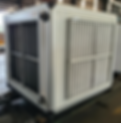What is HVAC (heating, ventilation and air conditioning) and how does it work?
- Anne Lee
- Nov 5, 2022
- 4 min read
Updated: Aug 29, 2025

Commercial Air Conditioner manufactured by TCW Group
The methods, procedures, and technologies used to keep an indoor environment at a desired range of physical conditions are collectively referred to as “HVAC”.
These conditions typically vary depending upon the type of activity carried out in the area. The temperature, humidity level, and air quality, for instance, are the most important factors if the area is the inside of a structure where people are present.
Because they are exposed to a variety of time-varying inputs, some of which are predictable while others are unpredictable or unintentional, the circumstances of all internal environments are dynamic.
For example, heat is lost to the outside during winter when the temperature outside is lower than the indoor temperature.
The HVAC (heating, ventilation and air conditioning) system must heat any cold air that enters the structure through openings and cracks to the appropriate indoor temperature.
In the summer, the air is often hotter and more humid outside. The temperature and humidity of indoor air also rises as a result of the occupancy of the building, indoor lighting, and various electronics.
Heat and moisture flows must be regulated by the HVAC system if appropriate indoor conditions are to be consistently maintained.
The three main tasks of heating, ventilation, and air conditioning are interconnected and interrelated in order to provide thermal comfort and appropriate indoor air quality.
Heating
Heating systems use many methods to deliver warm air. Heating can be done through water heating, steam heating, electric heating and via heat pumps.
Circulating water systems employ a closed loop to heat and then reheat the same water. A sealed system is a type of central heating system in which the heating water circulates independently of the building's normal water supply.
A steam heating system makes use of the high latent heat released when steam condenses to liquid water. Each room in a steam heating system has a radiator that is connected to a low-pressure steam source (a boiler).
Electric heaters are typically installed as part of a fan coil in a central air conditioner. They circulate heat by blowing air across the heating element, which is fed via return air ducts into the furnace.
A heat pump is a combined air conditioning and heating system. Heat pumps are available in both gas and electric types. Heat pumps do not produce heat in the same way that furnaces do. They relocate it.
In heating mode, a heat pump extracts heat from the air, water, or earth and transports it inside. A heat pump operates in reverse to cool by drawing warm interior air and sending it outside.

Air Handling Unit manufactured by TCW Group
Ventilation
The process in HVAC, "ventilation" is the changing or replenishing air in any room to control temperature or eliminate any combination of moisture, smells, smoke, heat, dust, airborne bacteria, or carbon dioxide, as well as to refill oxygen. It is a critical aspect in maintaining adequate indoor air quality in buildings.
An air handling unit provides mechanical ventilation, which is used to control indoor air quality. Excess humidity, smells, and pollutants can frequently be reduced or eliminated by dilution or replacement with outdoor air.
Often comes with air purifiers, which are devices that clean and deodorise the air. Humidifiers and dehumidifiers maintain a healthy level of moisture. Blowers and fans move the air.
Mechanical ventilation systems consist of supply fans (which push outdoor air into a building), exhaust fans (which draw air out of a building, causing equal ventilation flow into a structure), or a combination of both. Mechanical ventilation is frequently provided by equipment that also heats and cools a place.
Air Conditioning
The third and final component of a HVAC system is air conditioning, which is the polar opposite of heating. Its primary goal is to remove the current heat from the building’s interior. Air conditioning and refrigeration are enabled through the removal of heat.
Radiation, convection, and conduction can all be used to remove heat. The heat transfer medium is a refrigeration system, which uses refrigerants such as water, air, ice, and chemicals.
A refrigerant is used in either a heat pump system, where a compressor drives the thermodynamic refrigeration cycle, or in a cooling system, where pumps circulate a cold refrigerant.
There are two types of central air conditioners. A split system air conditioner has an indoor unit (air handler) and an outdoor unit (condenser unit). Heat is collected by the outside unit. The indoor unit, also known as the air handler, circulates the air and filters it.
Package system works in the same way as a split system, except all of the components are housed in a single outdoor unit.
The outdoor unit integrates both components of a split system into a single unit. Some packaged air conditioners can also function as heat pumps or furnaces. Packaged systems are ideal for areas with limited square footage.
Split systems are more efficient and have a lower footprint than package systems. Package systems, on the other hand, have a little lower indoor noise level than split systems because the fan motor is positioned outside.
Takeaway
You can better comprehend your home or building’s heating, cooling, and comfort demands now that you know about the HVAC heating and cooling system, as well as it's ventilation function.
Do you want to replace your current HVAC system? Or perhaps you want to add one entirely?
TCW Group is your dependable HVAC manufacturer and we are ready to serve all of your HVAC needs. Contact our team of experts for a consultation today!
